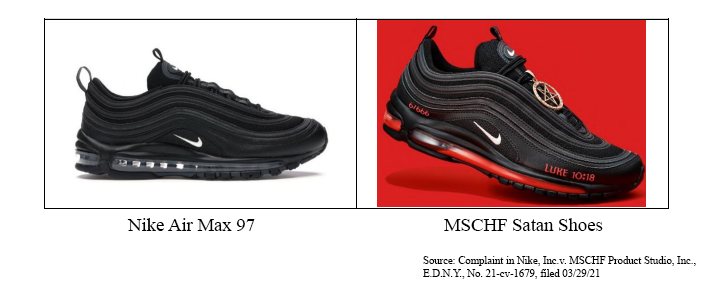“Wavy Baby” Case Tests Definition of an Expressive Work | Miller Nash LLP
Is the Wavy Baby a sneaker or a comment on “sneaker culture”? A commercial product or a collectible artwork? This is the most recent variation on a question that has had growing urgency in trademark law over the past decade: What is an expressive work?
To understand why the question is so important, we go back to 1989 when the Second Circuit issued its opinion in Rogers v. Grimaldi. Plaintiff Ginger Rogers of movie-musical fame sought to enjoin producers of the film Ginger and Fred from using her name in its title. The film’s title refers to its main characters, a pair of aging vaudeville entertainers who, using “Ginger and Fred” as the name of their act, struggle to perpetuate the dying art form that had been their bread and butter in better days. The parties agreed that those names inevitably evoke the famed cinematic dancing couple Fred Astaire and Ginger Rogers, and thus would call Rogers to mind. Rogers claimed that the film’s title was likely to confuse the public into believing that Rogers herself was in the film, played some role in its production, or sponsored or endorsed the film. The court recognized that, as a motion picture and as the work of one of the most distinguished filmmakers of the time, Federico Fellini, Ginger and Fred was a consummate example of a work of artistic expression, entitled to the highest degree of First Amendment protection. With that in mind, the court fashioned a two-step test to assess whether such an expressive work should be held liable to a Lanham Act claim for false endorsement: (1) Is the accused use (of Rogers’s name in the title) at least minimally artistically related to the work? and (2) Does the use explicitly mislead the public (as to Rogers’s involvement in the film)? Because the evocation of Ginger Rogers had at least minimal artistic relevance to the film, and nothing about the film, its title, or its promotion was explicitly misleading in suggesting that Rogers was involved with the film, the First Amendment won the day.
Over the ensuing years, the Rogers test evolved from a humble test to determine whether use of someone’s name in a film title should create Lanham Act liability into the test of choice for assessing the First Amendment protectability of the use of a name, image, likeness or trademark in an expressive work.
Fast forward to 2022.
In late September, the Second Circuit heard arguments from sneaker giant Van’s that its popular “Old Skool” sneaker is infringed by “Wavy Baby”—a creation admittedly based on and bearing similarity to the Van’s product, but altering the Van’s design in a number of ways, most notably by introducing an up-and-down curvy sole, evoking a chuckle and rendering the Wavy Baby arguably unusable as a sneaker. Wavy Baby is a creation of MSCHF, an arts collective known for culturally disruptive works unapologetically based on commercial products.
In 2021 Nike obtained a restraining order against an earlier MSCHF creation, the Satan Shoe, a collaboration with rapper Lil Nas X that was issued in 666 pairs of modified Nike Air Max 97s replete with red trim, satanic verses, and a drop of human blood. For Nike, the issue was not whether the Satan Shoe was an artwork or a competing commercial sneaker, but rather the public’s confusion as to whether Nike had authorized the shoe or participated in its creation and sale (which it had not). MSCHF’s earlier “Jesus Shoe” achieved no such notoriety, and evoked no legal action from Nike, though it, too, was a modification of actual Air Max 97s.
The Wavy Baby is, similarly, a deliberate modification of Van’s “Old Skool” sneaker, and Van’s concern, like Nike’s, is that the public will believe Van’s was involved in the creation and sale of the work. Like Nike’s claim against the Satan Shoe, Van’s complaint echoes the concerns of Ginger Rogers and seems to call for Rogers v. Grimaldi analysis. But in light of MSCHF’s statement that Wavy Baby is a parody of the Van’s shoe, the “artistic relevance” prong of the Rogers test would tend to favor MSCHF, forcing Van’s to demonstrate that Wavy Baby “explicitly misleads” the public—a dicey proposition. Instead, Van’s argues that Wavy Baby is not an expressive work at all and thus not entitled to Rogers analysis, but rather must withstand a straightforward Lanham Act likelihood of confusion test.
The same issue was the focus of recent arguments before the District Court for the Southern District of New York in Hermes International v. Mason Rothschild, in which the international fashion house Hermes alleges that a line of MetaBirkin NFTs created by designer Rothschild are not expressive works but competing consumer products that kock off Hermes’s famous Birkin Bags. The designer claims the NFTs parody the high-fashion bags and target NFT collectors, not customers of haute couture. But Hermes argues that the NFTs have a specific commercial use as bags carried by fashionable denizens of the still evolving “Metaverse”.
To further muddy the already turbid waters of the “expressive work” debate, Jack Daniel’s recently filed a second petition for certiorari, urging the U.S. Supreme Court to take up a case the Court already once declined less than a year ago. In Jack Daniel’s v. VIP, the Ninth Circuit ruled that a dog chew-toy in the shape of a bottle of Jack Daniel’s Old No. 5 sour mash whisky styled “Bad Spaniel’s Old No. 2” and sporting an array of jokes and puns based on dog excrement did not infringe or tarnish the Jack Daniel’s trademark. In so holding, the Ninth Circuit determined the chew-toy to be an “expressive work”, despite its being a commercial product, distributed, promoted, and sold to dog owners by a profit-making commercial company. Parody can indeed be an element of a consumer product; but does its presence make the product an expressive work? Again, the question is important because if a disputed product is dubbed an “expressive work” it is likely to get the virtual free-pass of Rogers analysis and not be held accountable for consumer confusion or alleged trademark harm.
All three of these cases are concurrently pending disposition, and could either bring clarity to the question of what is an expressive work and when Rogers analysis should apply, or create a perfect storm of even greater confusion.
[View source.]







